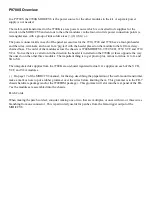
21
rounding Q15 emitter to collector.
With the collector of Q16 low, D15 will be forward biased and pin 8 of U1 will be at around
3V. If voltage at pin 8 of U1 is lower than the 3V, U1 is defective. Verify:
1.
correct value of R44
2.
D15 is not shorted and oriented correctly
H) Low Frequency Power Amp Test
1.
Amp pulls excessive power when board is connected.
Verify correct values of Q1 (2SC3281), Q13 (2SA1302), Q2 (2SD1763A), and Q12
(2SB1186A). Check that D6 and D7 are not shorted and for proper polarity. Look for pos-
ible shorts in the areas where these parts are. All the above parts form the “Current
Amplifier” (Providing current gain). Everything from Q6, Q8 and before, form the “Voltage
Amplifier” (Providing voltage gain).
If output voltage is centered (Close to ground potential), look for shorts to ground on output
leg (+LF test point).
If output voltage is centered (+LF test point), and output leg is not shorted, there could be a
problem with the bias reference. Jumper across C12. Power Unit. If excessive current is
not pulled, bring AC supply to full (120VAC). Measure across R9 and R21. The voltage
across these parts should not be any greater than 2.5VDC. Measure resistance of R9 and
R21, the correct value is 243 ohms. If R9 or R21 value incorrect, or if the voltage across
these parts is excessive proceed to “Voltage Amp Test”. If R9 and R21 testing doesn’t
uncover a problem, and shorting C12 does bring the power consumption to normal, proceed
to “Bias Reference Test”. Remove jumper across C12.
If the output voltage is offset (+LF test point) from ground there could be a problem in the
voltage amp. Jumper across C12 and then bring this point to ground. If the output voltage
centers itself, remove jumper and proceed to “Voltage Amp Test”. If the voltage does not
center, then the problem is in the current amplifier. Check for shorts on all elements (base
to emitter, base to collector, collector to emitter) of Q1, Q13, Q2, and Q12.
2.
No output from the amp when driven.
Verify signal at base of Q10. If there is no signal refer to “Low Frequency Filter Test”.
Verify that junction of R32 and Q15 collector is close to ground potential. If not close to
ground potential refer to “Amplifier Muting Test”. If all of the above is OK refer to “Voltage
Amp Test”.
3.
Does amp oscillate? Does amp roll off too soon at high frequencies?
Check all components that effect high frequency stability and response: C4, R2 (output
loading), C8, C15 (current amp stabilizers), C14, R15, and C11.
Содержание EON15
Страница 23: ...High Frequency Response EON Power15 and EON15P 1 230 33...
Страница 24: ...Low Frequency Response EON Power15 and EON15P 1 230 34...
Страница 30: ...Low Frequency Response EON PowerSub 40...
Страница 35: ...High Frequency Response EON Power10 45...
Страница 36: ...Low Frequency Response EON Power10 46...












































